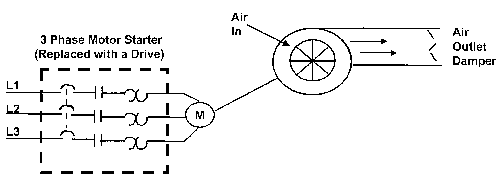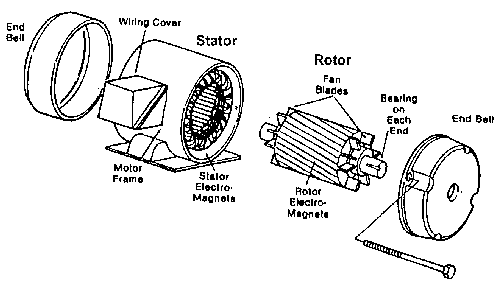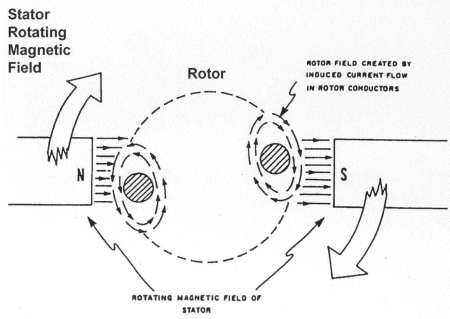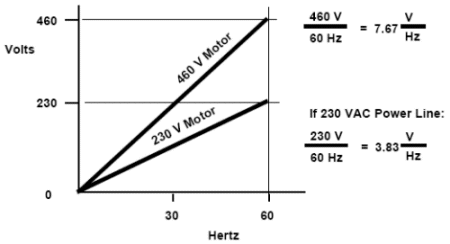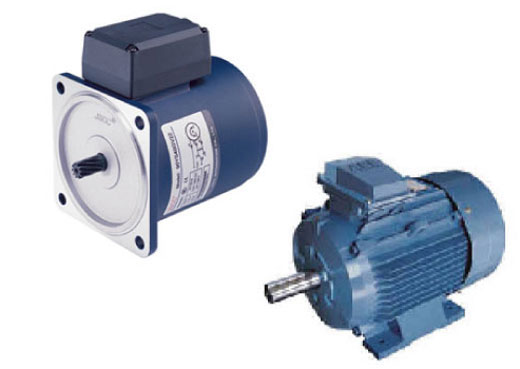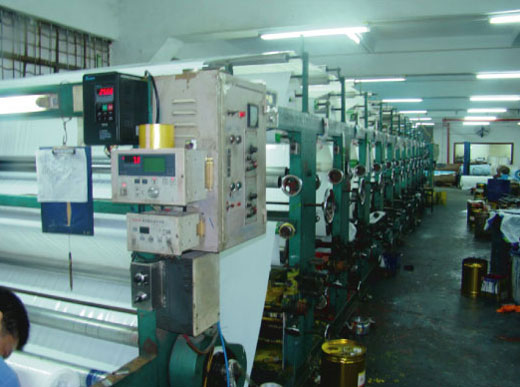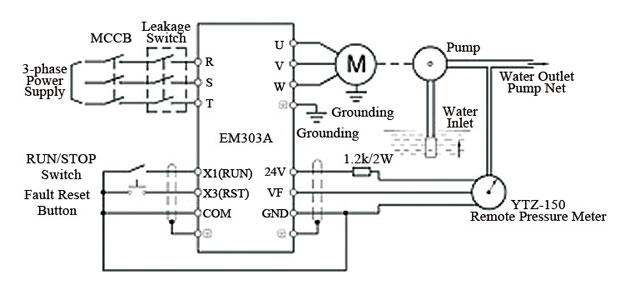An variable frequency drive is a device that is used to control the speed of an electrical motor, either an induction motor or a synchronous motor. AC drives are also known by various other names such as adjustable speed drive (ASD) or adjustable frequency drive (AFD) or variable frequency drive (VFD) or variable speed drive (VSD) or frequency converter (FC) or (FI) or AC drive or ac motor drive.
The word "drive" is used loosely in the industry. It seems that people involved primarily in the world of gear boxes and pulleys refer to any collection of mechanical and electro-mechanical components, which when connected together will move a load, as a "drive". When speaking to these people, an AC drive may be considered by them as the variable frequency inverter and motor combination. It may even include the motor's pulley - I am not sure.
The word "drive" is used loosely in the industry. It seems that people involved primarily in the world of gear boxes and pulleys refer to any collection of mechanical and electro-mechanical components, which when connected together will move a load, as a "drive". When speaking to these people, an AC drive may be considered by them as the variable frequency inverter and motor combination. It may even include the motor's pulley - I am not sure.
People in the electrical field and electrical suppliers usually refer to a variable frequency inverter unit alone, or an SCR power module alone (when discussing DC drives) as the "drive" and the motor as the "motor".
Manufacturers of variable frequency drives (VFD) used to refer to the drive as just that, a "variable frequency drive". More manufacturers are referring to their drive as an "adjustable speed AC drive". To make matters worse when a motor is included in the package it may be referred to as an "adjustable speed AC drive system".
A variable frequency drive is an adjustable speed drive. Adjustable speed drives include all types; mechanical and electrical. Now is it clear? Don't worry about it. It's not clear to anyone. As you read on, when I refer to the "drive" I am referring to the variable frequency inverter alone.
The first electrical AC motor was designed in 1899. Electrical motors convert electric energy into mechanical energy by electromagnetic induction. These motors are characterized by:
fixed speed, determined by the frequency of the power supply
fixed torque
Obviously, a fixed speed is not suitable for all processes in all circumstances; thus, the need for adjusting the speed according to need.
Industrial machinery is often driven by electrical motors that have provisions for speed adjustment. Such motors are simply larger, more powerful versions of those driving familiar appliances such as food blenders or electric drills. These motors normally operate at a fixed speed.
If speed control is required, that controller is called a (variable speed, variable frequency) AC drive. AC drives are used in a wide variety of industrial applications. To give an easy example, AC drives are often used with fans to provide adjustable airflow in large heating and air conditioning systems. The flow of water and chemicals in industrial processes is often controlled by adjusting the speed of pumps.
However, variable speed AC drive are commonly used in more complex and difficult environments such as water and wastewater processing, paper mills, tunnel boring, oil drilling platforms or mining.
The technology
The speed is controlled by changing the frequency of the electrical supply to the motor. The 3-phase voltage in the national electrical grid connected to a motor creates a rotating magnetic field in it. The rotor of the electrical motor will follow this rotating magnetic field. An AC drive convert the frequency of the network to anything between 0 to 300 Hz or even higher, and thus controls the speed of motor proportionally to the frequency.
1. Rectifier unit
The frequency inverter is supplied by the electrical network via a rectifier. The rectifier unit can be uni- or bidirectional. When unidirectional, the frequency inverter can accelerate and run the motor by taking energy from the network. If bidirectional, the frequency inverter can also take the mechanical rotation energy from the motor and process and feed it back to the electrical network.
2. DC circuit
The DC circuit will store the electrical energy from the rectifier for the inverter to use. In most cases, the energy is stored in high-power capacitors.
3. Inverter unit
The inverter unit takes the electrical energy from the DC circuit and supplies it to the motor. The inverter uses modulation techniques to create the needed 3-phase AC voltage output for the motor. The frequency can be adjusted to match the need of the process. The higher the frequency of the output voltage is, the higher the speed of the motor, and thus, the output of the process.
Figure 1: The main components of an AC drive: rectifier, DC circuit and inverter
The benefits
The types of motors that AC drives control are normally operating at constant speed. Enabling the user to control the speed of motor potentially gives him various benefits in terms of process control, system stress and energy savings.
Adjusting speed as a means of controlling a process
Smoother operation
Acceleration control
Different operating speed for each process
Compensate for changing process variables
Allow slow operation for setup purposes
Adjust the rate of production
Allow accurate positioning
Control torque or tension
System stress
Reducing the start-up current, which allows use of smaller fuses and supply connections and reduces peak loads on the electrical network
Reducing the mechanical shock in start and stop situations
Saving energy by using AC drives
An AC drive often uses less energy than an alternative fixed speed mode of operation. Fans and pumps are the most common energy saving applications. In these applications, energy savings are typically 20-50%.
When a fan is driven by a fixed speed motor, the airflow may sometimes be higher than it needs to be. Airflow can be regulated by using a damper to restrict the flow, but it is more efficient to regulate the airflow by regulating the speed of the motor.
Case study: AC drives in HVAC applications
40% of all energy in Europe and North America is consumed in buildings. The biggest share of this energy is consumed in heating, ventilation and air conditioning (HVAC) applications.
With the rising energy cost and concerns about the CO2 levels and global warming, it is crucial to use all means available to reduce the energy consumption in HVAC applications. The savings potential is big.
The key thing is to start looking more at lifetime costs of HVAC system, where energy cost plays a big role, rather than the initial investment in HVAC system. To give an example, 90% of the lifetime costs of the pump or fan is energy.
The majority of HVAC applications where AC drives are used are
fans
pumps
compressors.
Figure 2: The main components of an HVAC system: air circulation, water cooling circuits and water heating circuits.
1. Fans and pumps
Using an variable frequency drive to control the fan or pump output rather than using dampers, vanes, valves or on/off control brings substantial energy savings, if the required output is less than nominal most of the time.
The variable frequency drive controls the speed of the pump and fan by changing the electrical energy supplied rather than damping the air- or water flow. It is like reducing the speed of a car by pressing less on the accelerator instead of using the brake to slow down the speed. The payback time of an AC drive is typically one year or less.
Graph 1: Electrical power consumed by pump at partial loads is significantly less with an AC drive than with valve or on/off control.
Other benefits of using AC drive to control the speed of fan or pump are:
Smooth ramp up and ramp down causes less stress to the mechanics of fans and pumps and to air ducts and water piping
Slowing down the speed rather than damping the output will result in lower noise levels
Tuning the HVAC system during and after the commissioning is easier when the flexibility of an AC drive is used
2. Compressors
Compressors in HVAC are often used in chillers for cooling water, which again is used for cooling air. Utilising AC drives in compressor applications will potentially bring energy savings compared to on/off control.
Energy savings are achieved by optimising the system setup of compressor, chilled water circulation and condenser water circulation. The optimum set point for chilled water temperature and condenser water temperature is based on outdoor and indoor temperature and humidity.
The energy savings are most effectively achieved by tuning the system rather than optimizing individual functions. The variable frequency ac drive gives the flexibility of tuning the setup of the system to operate in the most energy efficient operational point.
Other benefits
Reduced number of starts and stops reduces the wear of the compressor
The piping and mechanics are stressed less in ramp up or –down situations
Reduced noise level in low load situations
Possibility to use high speed compressors
How does a variable speed drive work?
Speed Control
Variable speed ac drives for electric motors are able to accurately control the speed and power applied to the motor. The need for precision processing in manufacturing led to the creation and development of variable frequency drives for industry. Sophisticated automation lines for making automobiles utilize hundreds of these types of motor drives in one facility. Variable frequency motor drives have the capability of being electrically tied together so they can operate in concert with one another to move mechanical devices at a precision rate.All Voltage Equal
The pairing of a frequency drive with a motor begins with the voltage of the motor. Although some frequency drives can convert voltage to a lower or higher rating, the most efficient is when the motor and variable frequency drive is of the same voltage. The most common voltage for industry is a three-phase power at 480 volts alternating current (VAC). This type of voltage is able to efficiently send power to an appropriate motor and deliver the horsepower or torque that is required. Torque is a value that designates the amount of "push" or "force" a motor can deliver. Variable frequency drives allow the usage of this torque to deliver power to the electric motor and yet control the speed of that motor.
Hertz Frequency
All electrical power that is sent from the utilities runs at a certain frequency. This frequency is called a Hertz. Most generally, the frequency that is delivered over the large power lines is generated at the power companies in the form of 60 cycles per second, or 60 Hertz (Hz). A Hertz is best described as a full cycle or Sine wave of electrical power. This is where the alternating current goes from zero to a maximum positive voltage, back to zero again and then to a maximum negative voltage and then back to zero. Think of this like a clock face, where 12 o'clock is the beginning zero point of the Sine wave or a single Hertz. At 3 o'clock would be the maximum positive voltage. The 6 o'clock mark would be zero again. At 9 o'clock would be the maximum negative voltage and then back to 12 o'clock is again at zero. Now imagine this clock spinning at a speed where the large dial would make this cycle 60 times of every second. That is the physical characteristic of the electrical power that comes from the wall outlet. All electrical power is generated in this fashion.
Controlling the Frequency
Variable frequency drive take advantage of this generation characteristic of electrical power by being able to slow down or speed up the amount of times that clock face would spin in 1 second. Through a series of capacitors, diodes and an imbedded computer chip, the frequency drive is able to moderate speed while still delivering the full torque of power to the motor. The drive is able to not only vary the amount of frequency, but can also regulate the voltage that is being sent to the motor. It does this by delivering a full current to the motor. The current has a direct correlation to the amount of power that is delivered to the motor. The variable frequency drive may have special software that allows the controller to be tied to main computer. This computer can control a multitude of drives for a factory environment.
You can divide the world of electronic motor drives into two categories: AC and DC. A motor drive controls the speed, torque, direction and resulting horsepower of a motor. A DC drive typically controls a shunt wound DC motor, which has separate armature and field circuits. AC drives control AC induction motors, and-like their DC counterparts-control speed, torque, and horsepower.
The first stage of a variable speed drive, AC Drive, or VFD, is the frequency converter. The converter is comprised of six diodes, which are similar to check valves used in plumbing systems. They allow current to flow in only one direction; the direction shown by the arrow in the diode symbol. For example, whenever A-phase voltage (voltage is similar to pressure in plumbing systems) is more positive than B or C phase voltages, then that diode will open and allow current to flow. When B-phase becomes more positive than A-phase, then the B-phase diode will open and the A-phase diode will close. The same is true for the 3 diodes on the negative side of the bus. Thus, we get six current “pulses” as each diode opens and closes. This is called a “six-pulse VFD”, which is the standard configuration for current variable speed drives.
Let's take a brief look at a drive application. In Fig. 1, you can see a simple application with a fixed speed fan using a motor starter. You could replace the 3-phase motor starter with Variable Frequency Drive (VFD) to operate the fan at variable speed. Since you can operate the fan at any speed below its maximum, you can vary airflow by controlling the motor speed instead of the air outlet damper.
Figure 1, Fixed Speed Fan Application
A drive can control two main elements of a 3-phase induction motor: speed and torque. To understand how a drive controls these two elements, we will take a short review of AC induction motors. Fig. 2 shows the construction of an induction motor. The two basic parts of the motor, the rotor and stator, work through magnetic interaction. A motor contains pole pairs. These are iron pieces in the stator, wound in a specific pattern to provide a north to south magnetic field.
Figure 2, Basic Induction Motor Construction
Figure 3, Operating Principles of Induction Motor
With one pole pair isolated in a motor, the rotor (shaft) rotates at a specific speed: the base speed. The number of poles and the frequency applied determine this speed (Fig. 4). This formula includes an effect called "slip." Slip is the difference between the rotor speed and the rotating magnetic field in the stator. When a magnetic field passes through the conductors of the rotor, the rotor takes on magnetic fields of its own. These rotor magnetic fields will try to catch up to the rotating fields of the stator. However, it never does -- this difference is slip. Think of slip as the distance between the greyhounds and the hare they are chasing around the track. As long as they don't catch up to the hare, they will continue to revolve around the track. Slip is what allows a motor to turn.
| Motor Slip: | |||
Shaft Speed =
|
120 X FP
| - Slip | |
| Slip for NEMA B Motor = 3 to 5% of Base Speed which is 1800 RPM at Full Load | |||
| F = Frequency applied to the motor P = Number of motor poles | |||
| Example: | |||
Shaft Speed =
|
120 X 60 Hz4
| - Slip | |
Figure 4, Induction Motor Slip Calculation
| |||
We can conveniently adjust the speed of a motor by changing the frequency applied to the motor. You could adjust motor speed by adjusting the number of poles, but this is a physical change to the motor. It would require rewinding, and result in a step change to the speed. So, for convenience, cost-efficiency, and precision, we change the frequency. Fig. 5 shows the torque-developing characteristic of every motor: the Volts per Hertz ratio (V/Hz). We change this ratio to change motor torque. An induction motor connected to a 460V, 60 Hz source has a ratio of 7.67. As long as this ratio stays in proportion, the motor will develop rated torque. A drive provides many different frequency outputs. At any given frequency output of the drive, you get a new torque curve.
Figure 5, Volts/Hertz Ratio
Why should I using variable frequency drive?
A variable speed drive controls the speed of an ac motor, which provides flexibility to the process since speed can be changed easily for process optimization. It takes the fixed power supplied to it and converts it into a variable frequency and variable voltage source which then feeds a motor. This allows the drive to control the speed and torque the motor produces.
A variable speed drive may enhance the user’s profitability by improving the process, which in turn produces a fast return on investment (ROI). Process improvements may come from better:
Speed control;
Flow control;
Pressure control;
Temperature control;
Tension control;
Torque control;
Monitoring quality; and
Acceleration/deceleration control.
Many applications that use ac motors would benefit from the use of such drives because they can also reduce operating costs while improving the process. Reduced costs come from:
Increased system reliability;
Reduced downtime;
Reduced equipment setup time;
Energy savings;
Lower maintenance;
Smoother operation—less wear and tear; and
Power factor control.
The net result of these improvements is increased profitability.
Reduce Energy Consumption and Energy Costs
If you have an application that does not need to be run at full speed, then you can cut down energy costs by controlling the motor with a variable frequency drive, which is one of the benefits of ac drives. variable frequency drives allow you to match the speed of the motor-driven equipment to the load requirement. There is no other method of AC electric motor control that allows you to accomplish this.
Electric motor systems are responsible for more than 65% of the power consumption in industry today. Optimizing motor control systems by installing or upgrading to variable frequency drive can reduce energy consumption in your facility by as much as 70%. Additionally, the utilization of variable frequency drive improves product quality, and reduces production costs. Combining energy efficiency tax incentives, and utility rebates, returns on investment for variable frequency drive installations can be as little as 6 months.
Increase Production Through Tighter Process Control
By operating your motors at the most efficient speed for your application, fewer mistakes will occur, and thus, production levels will increase, which earns your company higher revenues. On conveyors and belts you eliminate jerks on start-up allowing high through put.
Extend Equipment Life and Reduce Maintenance
Your equipment will last longer and will have less downtime due to maintenance when it’s controlled by variable frequency drive ensuring optimal motor application speed. Because of the variable frequency drive optimal control of the motor’s frequency and voltage, the variable frequency drive will offer better protection for your motor from issues such as electro thermal overloads, phase protection, under voltage, overvoltage, etc.. When you start a load with a variable frequency drive you will not subject the motor or driven load to the “instant shock” of across the line starting, but can start smoothly, thereby eliminating belt, gear and bearing wear. It also is an excellent way to reduce and/or eliminate water hammer since we can have smooth acceleration and deceleration cycles.
WHAT TYPES OF SYSTEMS ARE BEST SUITED TO A VSD?
Systems that require control of flow or pressure are most suited to the use of a VSD. This is because the consumed power is roughly proportional to the cube of the flow, or speed of the motor . Such applications may include:
Fans and pumps: In applications where the flow of fluid is variable, considerable energy savings can be achieved by replacing existing throttling valves and dampers with VSDs.
Conveyors: For conveyors with varying speed or with varying material flow, a VSD can adjust to the changing load requirements.
Compressors and chillers: In the same manner as fans and pumps, compressors can take advantage of the energy saving that is achieved by varying the flow with a VSD.
ARE SOME SYSTEMS UNSUITED TO A VSD?
Systems with a high static head are unsuited to the use of a VSD. Static head is a measure of the pressure needed to make a fluid flow. This is a constant pressure and is independent of motor speed. When a high motor speed is needed to overcome the static head, the motor speed is no longer proportional to the flow rate. A small reduction in motor speed could result in a large drop in flow and a big reduction in machine efficiency.
In applications where the motor load remains more or less constant, a VSD is unlikely to achieve a significant saving, as the opportunity to reduce power is diminished.
WILL YOU BE ABLE TO RETROFIT A VSD TO AN EXISTING MOTOR?
An existing AC induction motor will be compatible with the application of a VSD. The viability of retrofitting the VSD will depend on:
the cost
the space available
the suitability of the application to variable speed control
You should also consider the additional energy savings that could be achieved by replacing the existing motor with an equivalent energy-efficient motor.
HOW DO YOU MATCH A VSD WITH AN EXISTING MOTOR?
It’s best to start with the motor and ensure it is suited to its task, i.e. that it’s not overloaded or oversized.
The first step is to define the operating profile of the load. This involves measuring the required torque and current consumption under all operating conditions.
Then, this profile needs to be examined to ensure, first, that the motor is correctly sized; secondly, that the installation is suited to the application of a VSD. The VSD must be sized to the motor load, based on the maximum current requirements under peak torque demands. A VSD cannot be sized using the kilowatt rating of the motor alone.
Suppliers of VSDs included in the ACA specified products list should help you to choose the correct product.
HOW DO YOU PERFORM SIMPLE SAVINGS AND PAYBACK CALCULATIONS?
To perform a useful payback calculation, application-specific data must be gathered from the installation. The load profile under all conditions must be measured or estimated. As each motor application is unique, only a costing exercise will reveal the potential savings of installing a VSD in a system.
For a simplified example of a payback calculation, see Example of a VSD payback calculation. Note that participation in the ACA scheme further reduces the payback period.
SHOULD YOU BE CONCERNED ABOUT HARMONICS?
All VSDs produce harmonics from pulsed current being drawn from the supply. Harmonics are multiples of the 50Hz supply frequency which become superimposed on the supply system. Harmonics can cause problems such as equipment and capacitor overheating, voltage distortion and equipment malfunction. However, the use of filters, sometimes available as part of a VSD, helps to minimise the effects of harmonics.
HOW CAN YOU FURTHER IMPROVE THE ENERGY EFFICIENCY OF YOUR DRIVE INSTALLATION?
If practical, motors and drives should be switched off when not in use.
For all new installations, energy-efficient motors should be used. The combination of a VSD and an energy-efficient motor ensures an economical and future-proof installation.
For retrofit applications, you should consider replacing standard-efficiency motors with equivalent energy-efficient ones. Energy-efficient motors are also included in the ACA, and those that have qualified included on the specified list.
The mechanical efficiency of the driven equipment and transmission system (i.e. pumps, fans, belts, etc) directly influences the efficiency of the overall drive system. It’s important that this equipment be regularly maintained and lubricated and that wear-and-tear of mechanical parts be monitored.
EXAMPLE OF A VSD PAYBACK CALCULATION
Consider an 11kW 2-pole EFF1 motor driving a product transfer fan for a milk powder processing plant. The fan motor operates 6,000 hours per annum. Air flow is controlled via a manual damper set to 80% open. The motor efficiency is 90.5%.
From the curve representing the system in Figure 2 below, we see how the damper setting reduces the input power requirement by a factor of about 0.9. A cost of electricity of €0.14 per kWh is assumed.
Figure 2: Damper vs. VSD control efficiencies (courtesy of The Carbon Trust)
Without VSD
The annual cost of running the motor without VSD is as follows:
ANNUAL RUNNING COST WITHOUT VSD =
Input power * Input power reduction factor * Run hours * Electrical cost
= (11kW/0.905) * (0.9) * (6000) * (€0.14)
= €9,188.95
|
With VSD
If the damper is replaced with a VSD, the curve in Figure 2 shows that the input power is now reduced to 58% of maximum when running at 80% of full load. If we assume that the combined efficiency of the motor and the VSD is now 86%, then the annual running cost of the motor combined with VSD can be calculated as follows:
ANNUAL RUNNING COST WITH VSD =
Input power * Input power reduction factor * Run hours * Electrical cost
= (11/0.905) * (0.58) * (6000) * (0.14)
= €6,231.63
|
Thus the annual cost savings achieved by replacing the damper with the VSD are as follows:
Cost savings with VSD = €9,188.95 - €6,231.63 = €2,957.32 p.a.
If we assume a cost of €6,000 to supply and install the VSD, taking support from the ACA scheme into account, this gives us the following payback period:
Payback period = €6,000 / €2,957.32 = 2.03 years
In this simplified example, a payback of two years has been calculated. The load profile has been simplified to a constant 80% of full load. In practice, a more detailed examination of a varying load profile would be needed to calculate the true annual running costs.
